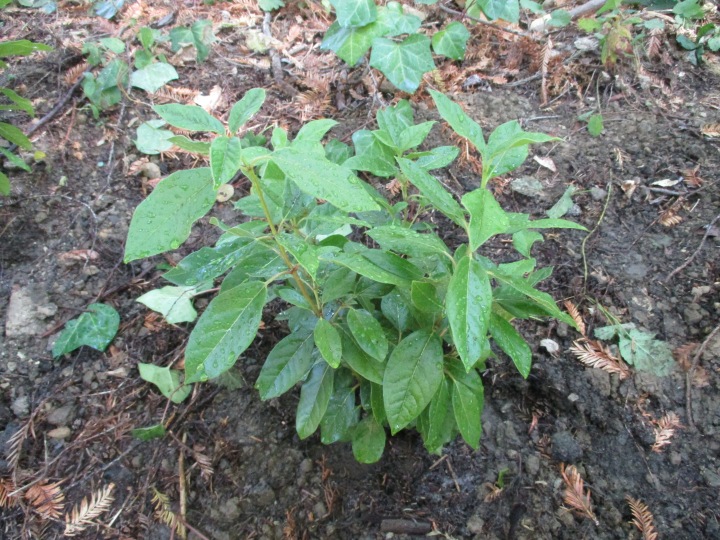A weed is a plant where it is not wanted. There are plenty here. There are also a few situations that could use some of the plants that are considered to be weeds in their present situations. Since we are not a ‘landscape’ company that earns more by needlessly disposing of, and installing, as much plant material as possible, we sometimes get to recycle some of our useful weeds.
Laurustinus, Viburnum tinus, which I refer to simply as ‘viburnum’, has politely naturalized here. It is not prolific enough to be invasive. It just has a sneaky way of getting around, mostly in irrigated landscaped areas. It lives in the wild too. It sometimes grows into situations where it is an asset. It sometimes becomes a problem. I don’t mind removing it. I am none to keen on it.
A thicket of viburnum is in the process of being removed from an area that will soon be outfitted with a new and more appropriate landscape. Rather than merely removing and disposing of all of the viburnum, we are relocating it into other landscapes where it will be more useful as informal screening hedges. I would prefer to wait until autumn, but the new landscape is waiting.
For the informal screening hedges that we want, these viburnums will work splendidly. They will fit right into the unrefined and unlandscaped areas as if they belong there. Prettier species that I would prefer would be more conspicuous, and look like something that was planted. I know that these recycled plants will initially not be as uniform as nursery stock, but I do not care.
1. This thicket of viburnum has been here as long as anyone can remember. It gets cut down when it gets too high, and takes a few years to regenerate. A new landscape will be going in here.
2. The biggest and gnarliest specimens get discarded. It would not be practical to salvage them. These mid-sized specimens with relatively compact root systems should be easily relocated.
3. They clean up nicely, with most of their foliage pruned away, and their long stems pruned back. Some of their roots get pruned to facilitate planting, and also to stimulate new root growth.
4. Once planted and soaked in, many of the relocated specimens seem to be comparable to what might have been purchased from a nursery. Even with the warm weather, wilting is minimal.
5. With two more that are out of view beyond the right margin of this picture, these five make a nice hedge of seven newly relocated viburnum. They are nothing fancy, but should work well.
6. This is the view that they are intended to obscure, featuring seven dumpsters and various utilitarian unpleasantries. That’s them in a neat row across the lower right corner of the picture.
This is the link for Six on Saturday, for anyone else who would like to participate:
https://thepropagatorblog.wordpress.com/2017/09/18/six-on-saturday-a-participant-guide/
We have a viburnum that puts up lots of shoots and swamps a bed I want for other plants. I’m not sure what to do with it – when I cut the shoots back they come right back with a vengeance.
LikeLiked by 1 person
That is how our thicket developed. They need to be pulled up with their roots.
LikeLiked by 1 person
That is easier said than done!
LikeLiked by 1 person
Yes, but it is not as difficult as cutting them repeatedly, and then eventually pulling up gnarled stumps that were cut back a few times as they continued to disperse their roots.
LikeLiked by 1 person
I think we may already be at the gnarled stumps stage!
LikeLiked by 1 person
Many of our were too. It was pretty nasty. I could not recycle the bigger ones, so needed to discard them. Removing them was no fun.
LikeLiked by 1 person
Very smart repurposing of those Viburnum. That definition of weed has always bothered me a bit. What about neurotic gardeners who can’t make up their minds if they want the plant there or not? Then the plant is a semi-weed?
LikeLiked by 1 person
There are a few weeds that I really like. I think that the Acacia dealbata is exquisite in bloom. If there were one in my garden, I would be hesitant to cut it down. I grow a blue gum eucalyptus for the aromatic foliage. It gets pollarded, but is a blue gum nonetheless.
LikeLiked by 1 person